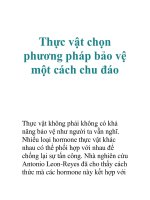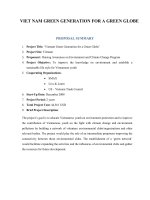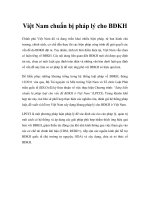Tiêu chuẩn bản vẽ kĩ thuật mĩ
Bạn đang xem bản rút gọn của tài liệu. Xem và tải ngay bản đầy đủ của tài liệu tại đây (1.3 MB, 39 trang )
Technical Drawing
MEC1000
Spring 2006
Instructor: David Anderson
Topics
•
•
•
•
Drawing Views
Drawing Standards
Best Practices
Creating Drawings in SolidWorks
Spring 2006
MEC1000 Technical Drawing - D. Anderson
2
Drawing Views
•
•
•
•
•
•
•
•
•
Multi-View Projection - The Glass Box
Third Angle Projection
Two View Drawings
Line Types
Section Views
Auxiliary Views
Detail Views
Broken-Out Section Views
Partial Views, Cropped Views
Spring 2006
MEC1000 Technical Drawing - D. Anderson
3
Drawing Views – Multiview Projection
• A view of an object is know technically as a
projection
• A projection is a view conceived to be drawn or
projected on to a plane, known as the plane of
projection
• Multiview or orthographic projection is a system of
views of an object formed by projectors from the
object perpendicular to the desired plane of
projection. Huh?
Spring 2006
MEC1000 Technical Drawing - D. Anderson
4
Drawing Views – Multiview Projection
• The projection of an object.
• Perpendicular lines or projectors are drawn from all points
on the edges or contours of the object to the plane of
projection.
• Shown below is the projection of an object onto the
frontal plane.
Spring 2006
MEC1000 Technical Drawing - D. Anderson
5
Drawing Views – Planes of projection
likewise,
• the top view is projected onto
the horizontal plane
• the side view is projected onto
the profile plane
Spring 2006
MEC1000 Technical Drawing - D. Anderson
6
Multiview Projection – The Glass Box
• Placing parallel planes to the
principal planes forms a glass
box (always observed from
outside the box)
• To show views of a 3D object on
a 2D piece of paper, it is
necessary to unfold the planes
such that they lie in the same
plane
• All planes except the rear plane
are hinged to the frontal plane,
which is hinged to the left-side
plane
Spring 2006
MEC1000 Technical Drawing - D. Anderson
7
Multiview Projection – The Glass Box
• By unfolding the box, six views of the object are
possible.
Spring 2006
MEC1000 Technical Drawing - D. Anderson
8
Drawing Views – Third Angle Projection
Spring 2006
MEC1000 Technical Drawing - D. Anderson
9
Multiview Projection – Proper number of
Views
• It may not, be necessary to show all six views to
completely describe the object.
• In fact, the minimum number of views is preferable.
• How many views are necessary to completely
describe this plate?
• 1?
• 2?
• 3?
• 4?
Spring 2006
MEC1000 Technical Drawing - D. Anderson
10
Multiview Projection – Two View Drawings
• The answer is 2!
Spring 2006
MEC1000 Technical Drawing - D. Anderson
11
Drawing Views – Sectional Views
•
•
We have covered the basic method of representing an object by projecting
views. This allows us to see the external features of an object.
Often times it is necessary to view the internal features, this is accomplished by
slicing through the object and producing a sectional or section view
Section view is always placed BEHIND arrows
Object being
sectioned
Section Line
Always a phantom
line type
View Arrow
With Label
Spring 2006
MEC1000 Technical Drawing - D. Anderson
12
Drawing Views – Sectional Views
Sectional views are extremely useful in minimizing the number of
projected views. How many views does this object require?
Spring 2006
MEC1000 Technical Drawing - D. Anderson
13
Drawing Views – Sectional Views
Section views provide clear and unambiguous representation of
internal features
Spring 2006
MEC1000 Technical Drawing - D. Anderson
14
Drawing Views – Sectional Views
Section views can reduced the number of views of many
axisymmetric parts to a single view
Spring 2006
MEC1000 Technical Drawing - D. Anderson
15
Drawing Views – Auxiliary Views
• Inclined planes and oblique (neither parallel nor perpendicular)
lines appear foreshortened when projected to the principle
planes of projection.
• To obtain a true size view, auxiliary views are created using
similar techniques as for creating standard views, unfolding
about an axis…
Spring 2006
MEC1000 Technical Drawing - D. Anderson
16
Drawing Views – Detail Views
When there is a great disparity between feature size, or views are overcrowded with
dimensions, a detail view can be used to capture the feature(s) of interest and
display them in a removed view of greater scale.
Detail View
Designated by an
Enclosed circle
and labled.
Removed
And scaled
Labeled and
scale noted
Spring 2006
MEC1000 Technical Drawing - D. Anderson
17
Drawing Views – Broken-Out Section
Broken-out Section views are essentially partial section views with out the section
arrow. Often times they are used to expose a feature of interest while eliminating
the need to create another view.
What is wrong with this drawing?
The auxilary view is NOT behind
The view arrows!
Broken out
Section – No label
necessary
Spring 2006
MEC1000 Technical Drawing - D. Anderson
18
Drawing Views – Partial Views
Partial views are removed views and are established in a similar manner as section
views, that is they require view arrows to establish viewing direction. However, they
do not have to section an entire object, rather can simply display a partial view of a
projection at a larger scale if desired.
What is wrong with this drawing?
Nothing!
Partial Section Line
w/Labled Arrows
Removed partial section view
Springnoted
2006
Labled and scale
MEC1000 Technical Drawing - D. Anderson
19
Drawing Views – Cropped Views
Cropped views reduce the size of a view such that only necessary information is
displayed. Cropped views also maximize the sheet area by reducing view size.
Crop AreaView
Cropped
Spring 2006
MEC1000 Technical Drawing - D. Anderson
20
Drawing Standards
• ASME responsible for mechanical drawing standards
• Sheet Formats
• Line Types
• Dimensioning Rules and Schemes
Spring 2006
MEC1000 Technical Drawing - D. Anderson
21
Drawing Standards - ASME
•
There exists standards and practices for creating technical drawings of
mechanical parts and assemblies. The governing agency responsible
for setting the standards is ASME. There are a number of documents
published by ASME that cover various aspects of mechanical drawings,
here are a few of them…
•
•
•
•
•
•
ASME
ASME
ASME
ASME
ASME
ASME
•
It is important to follow these standards to ensure your drawings are
interpreted correctly by others.
Always consult the standard when it doubt!
•
Spring 2006
Y14.100 -2004 Engineering Drawing Practices
Y14.4M - 1989 Pictorial Drawing
Y14.3M – Multi and Sectional View Drawings
Y14.1 - 1995 Decimal Inch Drawing Sheet Size and Format
Y14.5M – 1994 Geometric Dimensioning and Tolerancing
Y14.13M - 1981 Mechanical Spring Representation
MEC1000 Technical Drawing - D. Anderson
22
Drawing Standards – Sheet Formats
• There exist standardized sheet formats for creating engineering
drawings.
• American National Standard
•
•
•
•
•
A - 8.5” x 11”
B – 11” x 17”
C – 17” x 22”
D – 22” x 34”
E – 34” x 44”
•
•
•
•
•
A4
A3
A2
A1
A0
• International Standard ISO (mm)
Spring 2006
–
–
–
–
–
210
297
420
594
841
x
x
x
x
x
297
420
594
841
1189
MEC1000 Technical Drawing - D. Anderson
23
Drawing Standards – Sheet Format
Example C-Size
Revision Block
Notes
Zone Identifiers
Border
This is zone “C4”
Title Block
Spring 2006
MEC1000 Technical Drawing - D. Anderson
24
Drawing Standards – Sheet Formats
Revision Block
Drawing
Notes
Default
Tolerance
TEXT IS ALL CAPS! NO LOWER CASE.
Tolerance
Block
Engr Info
Company Name
Part #
Part Name
Default
Surface
Finish
Spring 2006
WIDGET
Scale
MEC1000 Technical Drawing - D. Anderson
Part Rev
# of Shts
25









